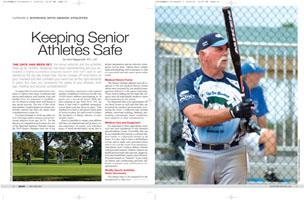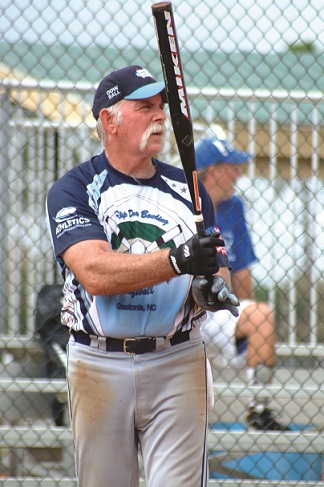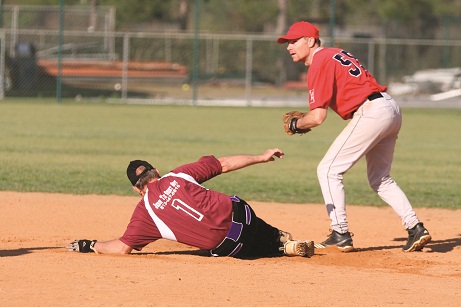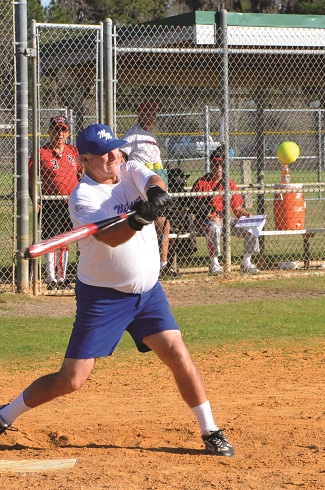
 |
| Photo courtesy Brackenridge Park Golf Course/ SACVB |
The date has been set, the venue selected and the activities lined up for months. Response has been overwhelming and you anticipate a highly successful program launch and can’t wait to get started as the big day draws near. You’ve crossed off most items on your checklist and feel confident your event has all the right elements in place. But have you considered the safety of your athletes, their age, medical and security considerations?
As aging baby boomers and seniors continue to explore new areas of interests and sports participation and leading long and healthy lives, it’s important to establish a set of criteria to ensure their well-being in any sports activity. The size of the event and number of participants are always important criteria, but there are many other considerations to plan for.
 |
| Photo courtesy of International Senior Softball Association |
I’ve been fortunate to work my entire career with high caliber amateur and professional athletes from age 18-70. As the director of competition and venues for one of the National Summer Olympic Games, the 2005 Senior Olympics was one of my most rewarding experiences and required careful coordination of services for the over 10,000 senior athletes participating in 18 sports over a two-week period. With athletes ranging in age from 50 to 103, we knew it was vital to establish emergency action plans and put them in place. This enabled us to have a full sports safety plan of action in place for each event to reduce the incidence of illness, chronic or catastrophic injury.
Here’s a checklist to ensure your athletes will have an inspirational and positive on-site experience. In return, you will have peace of mind should injury occur, due to proper preparation and an effective emergency action plan. Taking these simple steps and planning well in advance is vital to a successful and safe senior sports safety event:
Medical History Forms
The Senior Olympic athletes were all required to fill out medical history forms which were reviewed by our medical management staff prior to the games beginning. Those seniors falling into the high risk category were all individually spoken to upon their registering for the games.
 It’s important that your participants fill out these forms as well and that they are reviewed by medical professionals overseeing the event. Conditions may include asthma, exertional sickling, diabetes, pre-existing concussions, heart conditions, prior surgeries or other considerations.
It’s important that your participants fill out these forms as well and that they are reviewed by medical professionals overseeing the event. Conditions may include asthma, exertional sickling, diabetes, pre-existing concussions, heart conditions, prior surgeries or other considerations.
Medical Care and Equipment
It’s important to have appropriate medical care and equipment at any planned special athletic events. If possible, this can be accomplished by having a certified athletic trainer or a physician present at all times. It is also vital to have a defibrillator on-site and to make sure personnel know how to use it in the event of an emergency. And please don’t confuse athletic trainers with personal trainers! Athletic trainers are health professionals who prevent, diagnose, treat and rehabilitate injuries and illnesses. Personal trainers or “trainers” focus solely on fitness and conditioning and have different academic and certification requirements.
 |
| Photos courtesy of International Senior Softball Association |
Modify Sports Activities When Necessary
You always have to be prepared for the unexpected so that you are ready if the “what ifs” happen. If temperatures are above a certain degree you may have to modify some schedules for some outdoor or indoor events held in non-air conditioned buildings. It may be important to stop competition during the heat of the day and extend play into the evening when heat isn’t as major a concern. Make sure that hydration stations are well placed, manned and functioning during athletic activities.
Be Aware and Prepared for Certain Health Conditions
Below are three specific health conditions to be aware of and monitor closely. There are obviously dozens of health conditions we could include here but have chosen three that have gotten a lot of national attention lately and where immediate medical and on-site is essential.
I’ve highlighted select recommendations from the National Athletic Trainers’ Association and its recent publication of the “Preventing Sudden Death in Sports” position statement published in the February 2012 Journal of Athletic Training. To review this document please visit:
http://www.nata.org/sites/default/sites/sportsdestinations.com/files/Preventing-Sudden-Death-Position-Statement_2.pdf
Hydration and Exertional Heat Illness
Hydration is an extremely important concern when dealing with seniors, especially when events take place in the summertime when heat and humidity play a major role. Should an incident occur:
• Cool first, transport second: immediate cold water immersion is critical to reducing the temperature rapidly and maximizing odds the individual will survive.
• Determine core body temperature soon after collapse to ensure accurate and immediate assessment of a patient with suspected exertional heat stroke.
 |
| Photo courtesy of International Senior Softball Association |
Brain Injuries/Concussions
• When a serious brain injury is suspected in a non-responsive athlete, the clinician must be prepared to provide hyperventilation and to administer intravenous diuretics and elevate the head to help decrease intracranial pressure.
• Proper management of a less serious brain injury, such as a concussion, must still be managed carefully using follow up assessments of symptoms, neurocognitive function and balance, prior to initiating a gradual return-to-play progression.
Sudden Cardiac Arrest
• Recognition is key to treatment: sudden cardiac arrest should be suspected in any athlete who has collapsed and is unresponsive.
• Public access to early defibrillation is essential: a goal of less than 3-5 minutes from the time of collapse to delivery of the first shock from an AED is strongly recommended.
As mentioned earlier, it is also critical for any event to have an Emergency Action Plan in place – a written document that serves as a blueprint should injury or illness occur. This comprehensive document lays out a chain of command, important medical services and phone numbers (cell and land line) and specific directions to a venue that can truly save a life. Reviewing this document annually and with the input of a medical team, venue staff and local EMS services on a routine basis is vital to properly managing emergency situations.
Emergency Vehicles
Special consideration should be given to events requiring road races or activity where a fully staffed emergency vehicle is necessary. If your event involves a bicycle or running race, this should all be coordinated with the local police. They can assign motorcycles to lead a race and bring up the rear as well as control traffic at the various intersections along the race course.
Medical Supply List
Formulate a medical supply list so staff has what they needed in order to be able to take care of the athletes. These supplies included fully equipped medical kits to have at each location. The planning this had to be done months prior to the event so there would be time to order the supplies, receive them and stock the medical kits prior to competitions.
 |
| Photo courtesy of Fast-Dry Courts, Pompano Beach, FL |
Security
Security must also be addressed at these events and this planning must start early as there are often times overlapping jurisdictions that must be coordinated. This can involve local police, park police, county police or state police. Allow for plenty of lead time to ensure all logistics, communication and coordination are in place. Security may be required not only for your specific event, but for housing areas, loading and unloading areas for spectator and contestants buses as well as security along the bus routes.
Traffic Control
Traffic control is also a major issue that has to be addressed. Some schedules may have to be to be modified so as not to interfere with rush hour traffic especially concerning running and cycling events.
By paying proper attention to all aspects of your event during the planning stage, you will help to alleviate any sports safety challenges before they occur and ensure the peace of mind and care of your participants so they can strive to achieve their personal and professional goals on the playing field – and come back next year!

